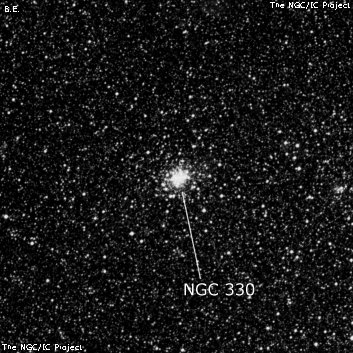
10x30 IS binoculars (11/4/12 - Coromandel Peninsula, New Zealand): visible as a very small, but non-stellar knot.
James Dunlop discovered NGC 330 = D 23 = h2367 on 1 Aug 1826 with a 7" reflector and recorded "A small, but very bright nebula, exceedingly condensed. This is the brightest nebula in the small cloud. I think I perceive two bright nuclei in this body." Dunlop observed the cluster 8 times during his survey and his position was just 2' N of the cluster.
John Herschel observed the cluster on 5 separate sweeps, first recording on 11 Apr 1834, "pretty bright, small, oval, resolved, 60"." His second sweep reads "globular cluster, S, B, little elliptic, gbM; 2' across. Fairly resolved into rather large and not very crowded stars." His third observation reads "globular cluster, vB, S, lE, resolvable or resolved; 90" long, 60" broad; a close compressed knot of stars with outliers."
400/500mm - 18" (7/6/02 - Magellan Observatory, Australia): this is one of the brightest SMC clusters and a fascinating object at 228x. It appears as a bright, extremely rich knot of stars, just 1' to 1.5' diameter, which was only partially resolved. Streaming out from the dense core are numerous mag 12 and fainter stars, some arranged in a curving chain off the following side of the core. The bright outliers seem scattered about to at least 5' (Hodge Association 40). NGC 330 is situated 20' SW of the remarkable HII region NGC 346 within a rich star field!
600/800mm - 25" (10/17/17 - OzSky): at 397x; extremely bright, fairly large, elongated NW-SE, ~1.5' diameter, high surface brightness cluster. Easily over 20 stars were resolved in central region and more than three dozen including outliers around the periphery. NGC 330 is situated in a rich, glowing section of the SMC just 20' SW of NGC 346, the top HII region in the SMC.
Notes by Steve Gottlieb